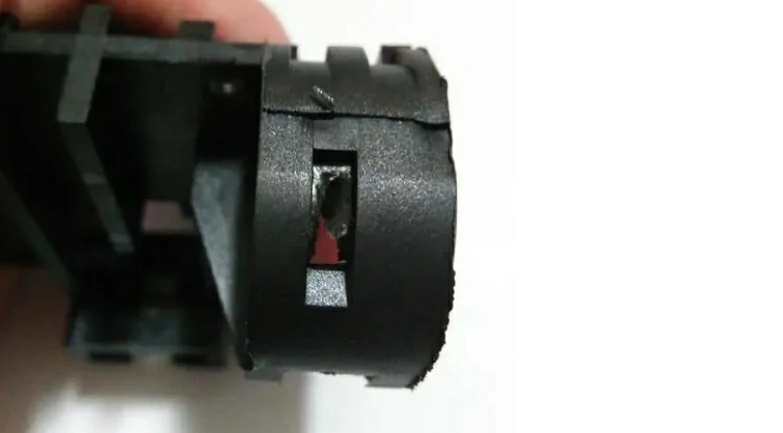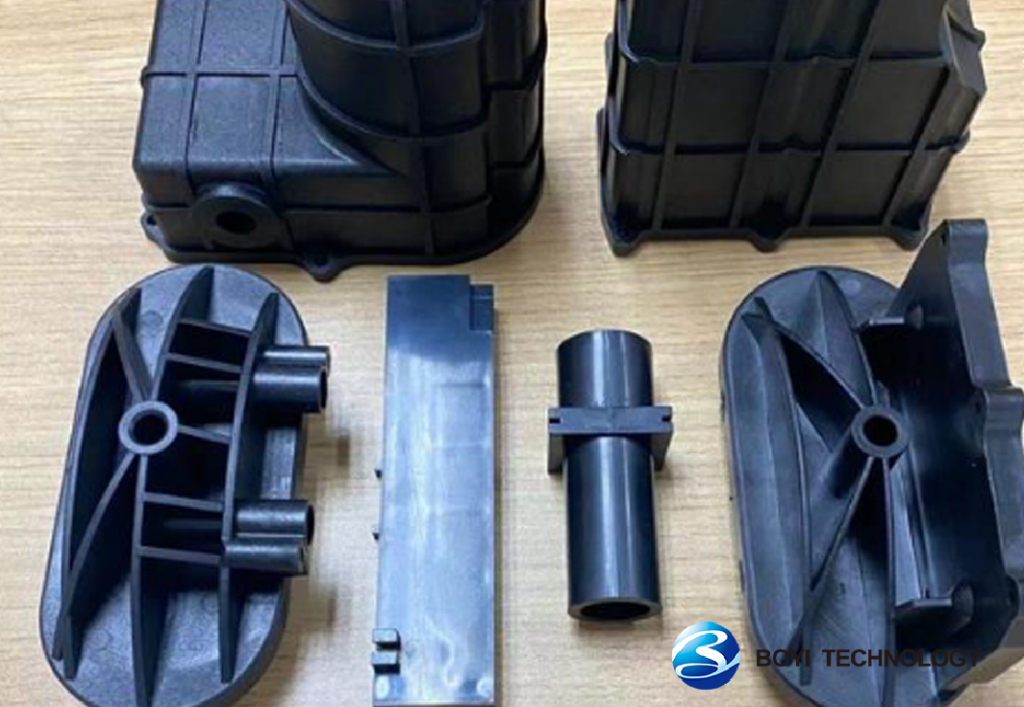Injection molding flash(deflashing) is a common issue in the production process of injection-molded parts, characterized by excess plastic formed on the surface of the parts. While a small amount of flash is considered normal in the plastic injection molding process, excessive flash can not only affect the surface finish of the parts but also potentially impact the overall product quality.
Although we have previously discussed in detail the solutions for addressing injection molding sink marks and weld lines in the preceding two articles, dealing with injection molding flash is no easy task, as it requires additional resources and may affect the efficiency of the entire process.
To identify and address part flash issues, manufacturers need to gain a deep understanding of the root causes of flash formation and take corresponding measures to prevent and reduce its occurrence.
Continue reading to learn more about plastic injection molding flash. If you are planning to embark on a new plastic injection molding project, consider obtaining our professional quotation. During this process, you will receive Design for Manufacturability (DFM) feedback, where our expert team will provide optimization suggestions tailored to your design to minimize the occurrence of flash.
What is an Plastic Injection Molding Flash?

Flash in injection molding (also known as deflashing) refers to the excess plastic material formed on the finished parts during the injection molding process, leaking out from the parting line of the mold or the gap between two mold sections.
These excess plastic edges typically occur at the gaps between the two halves of the mold, slides, or movable components. However, the most common occurrence is along the parting line, where the two main sections of the mold (the moving and stationary halves) come into contact when closed.
This flash often appears as thin films or thin flakes connected to the main body of the injection-molded part. Generally, up to 0.1 mm of flash is considered acceptable unless there are specific requirements for surface smoothness of the plastic part.
The severity of injection molding flash can vary due to several factors. Mild flash may only protrude slightly from the surface of the part, while severe flash may form noticeable or even sharp edges, which could affect the appearance, dimensional accuracy, and functionality of the plastic part.
What Causes Flash in Plastic Injection Molding?
In the injection molding process, flash is a common defect, and its occurrence can be attributed to various factors. Here are several primary reasons leading to the generation of injection molding flash:
Parting Line Mismatches
In injection molding, when the two halves of the mold are not properly aligned, resulting in a gap at the mold parting line, molten plastic can escape from the gap, leading to flash formation. While manufacturers strive to eliminate gaps through mold assembly, prolonged usage or the presence of contaminants can still cause mismatches at the parting line.
Even with well-designed molds and absence of contaminants, improper clamping pressure or extremely complex shapes can also result in flash. Regular cleaning and maintenance of the mold, along with sound mold design, are key to reducing flash.
Improper Venting
In injection mold design, mold manufacturers need to incorporate vents in the mold so that air can escape, allowing molten plastic to completely fill the cavity. If vents are improperly designed or blocked, air trapped in the cavity cannot escape in a timely manner. This leads to the compression of trapped air during the injection process, increasing pressure inside the mold and forcing the molten material to flow towards the parting line or other gaps, resulting in flash or defects.
Effective venting design requires consideration of the size, number, and placement of vents. Vents need to be sufficiently large to ensure rapid air evacuation while also being small enough to prevent molten plastic from flowing out through the vents.
Insufficient Clamping Pressure
Clamping pressure is the force required during the injection process to ensure that the mold remains tightly closed. When clamping pressure is insufficient, even with a well-designed parting line, high injection pressure may force the mold open, leading to a series of issues. The most obvious manifestation is the occurrence of injection molding flash.
Operators need to set the clamping pressure appropriately based on the specific requirements of the product and the design of the mold to ensure that the mold remains securely closed during the injection process, thus producing high-quality products.
Low Viscosity and Unbalanced Plastic Flow
The viscosity and fluidity of plastic are critical factors determining product quality. When the viscosity of molten plastic is low, its fluidity increases, making it prone to flow out from the parting line of the mold or other minor gaps during the injection molding process, resulting in flash or other defects.
Low viscosity can also lead to unstable product dimensions because the flow rate of plastic in the mold may slow down due to insufficient viscosity, resulting in issues such as short shots and shrinkage voids.
Plastic Overfilling Mold
Overfilling of the mold is typically caused by injection pressure exceeding clamping force.
When molten plastic is injected into the mold in excess, the injection pressure may exceed the clamping force, causing leaks at the mold parting line or other minor gaps. These leaked plastics will form unwanted attachments on the final product, known as flash.
However, caution must be exercised when adjusting feed settings to reduce overfilling. This is because plastic shrinks during the cooling process, and insufficient injection volume may result in short shots, where parts of the product are not fully filled, leading to incomplete parts.
How to Reduce Flash in Plastic Injection Molding?
When it comes to eliminating flash, industry standards typically require that plastic part flash be less than 0.10mm to ensure smooth edges and avoid discomfort for users. However, for applications in industries that demand high precision, such as medical, flash control of 0.05mm or smaller is often required.
If you’re embarking on a new injection molding project, BOYI Technology recommends clearly communicating your requirements with your injection molding partner during the quotation and DFM stages. This way, manufacturers can adjust processes and quotes based on your needs to ensure the final product meets your expectations.
Put your parts into production today
All uploads are secure and confidential.
To avoid issues with injection molding flash, you can take the following measures:
Design For Manufacturability(DFM)
Design for manufacturability (DFM) is an approach that considers manufacturability during the design phase of a product.
Specifically, DFM can assist designers in determining key parameters such as ideal injection mold gate design, wall thickness, hole design, and mold parting line design. Simultaneously, it helps to avoid overly complex designs, thereby reducing the need for special features required in complex processes like insert injection molding, consequently lowering the cost of injection molds.
The importance of DFM is particularly prominent in prototype injection molding. As prototyping often needs to be completed within a short timeframe and requires frequent modifications and optimizations, ensuring manufacturability through DFM can significantly shorten the product development cycle and enhance production efficiency.
Parting Line
To detect and address parting line mismatch issues, it’s essential to regularly clean the mold, inspect and repair any worn or damaged parts, and ensure proper alignment and fastening of the mold.
Another approach involves a process called “spotting.” Spotting entails applying a specific pigment to one half of the mold, then closing the mold halves. When the mold is opened, the pigment transfers to the other half of the mold, revealing any issues requiring additional mold assembly. This method provides a visual and rapid way to detect parting line mismatches, as demonstrated in the video below.
This approach provides a visual and rapid way to detect parting line mismatches.
Clamping Pressure
During the mold design phase, it’s crucial to fully consider the demand and distribution of clamping force, optimize mold structure, and improve the mold’s closure accuracy and stability.
Additionally, mold manufacturers should conduct fill-only part tests before commencing production. If excessive flash is observed, the clamping tonnage of the injection molding machine should be checked to ensure it can provide sufficient clamping force to keep the mold closed. Meanwhile, all debris should be cleared from the mold.
During the injection molding process, ensure that the clamping force exceeds the pressure generated inside the mold during injection to prevent mold separation and plastic leakage.
Slow Down the Injection Rate
By reducing the injection speed, the pressure exerted by the molten material flow can be decreased, allowing for more uniform flow and filling within the mold, thus reducing the occurrence of flash.
Simultaneously, lowering the injection speed also provides the molten material with more extended cooling time within the mold, aiding in reducing internal stresses in the product, thereby enhancing dimensional stability and surface quality.
Using a Flash-Free Mold
Flash-free mold, also known as high-precision molds, feature extremely strict manufacturing tolerances and precise closing mechanisms, which can significantly reduce or eliminate flash resulting from improper mold closure or excessive injection pressure.
However, the cost of flash-free mold is typically higher because they are manufactured through high-precision machining and stringent quality control to ensure precise alignment and tight closure of all mold components, thereby preventing plastic overflow under high pressure to form flash.
For many businesses, the cost of flash-free mold may exceed the budget. In such cases, traditional molds can be chosen, with subsequent processes like deburring, polishing, etc., used to further improve the appearance and quality of the products.
Contact BOYI for Injection Molding Services
BOYI possesses deep expertise and extensive experience in plastic injection molding part manufacturing, making us your trusted partner in injection molded part production. Through our ISO-certified stringent quality management system, we ensure that each of your parts meets the highest quality standards while minimizing the generation of flash.
Are you ready to start your injection molding project? Contact us now to request a free quote.
Put your parts into production today
All uploads are secure and confidential.
Conclusion
The generation of injection molding flash can stem from various factors, but measures such as optimizing mold design, maintaining and cleaning molds, selecting appropriate plastic materials, adjusting injection molding process parameters, and reinforcing operational standards can effectively reduce the occurrence of flash.
This article has extensively explored troubleshooting injection molding flash. We hope this article addresses your queries. If you wish to learn more about injection molding defects, please read this article: Top 10 Injection Molding Defects Causes and Solutions
FAQ
The key difference between a flash and a burr is that a flash refers to excess plastic material escaping from a mold in plastic injection molding, while a burr refers to a raised metal edge formed during metalworking operations like shearing and punching.Burrs are also known colloquially as “flash” in some contexts, but in the precision metalworking industry, the term “burr” is more precise.
Flash is an unwanted protrusion of material escaping from a mold, while parting line is the interface between mold halves that defines the shape of the cast part. Excessive flash may occur along the parting line due to mold wear.
Tagged: Injection Molding Guide



